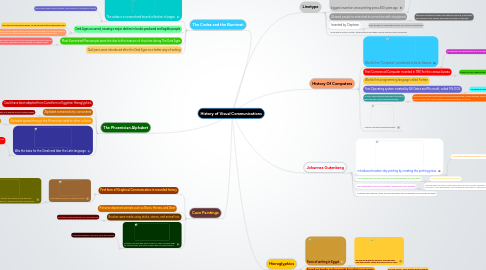
1. Cave Paintings
1.1. First form of Graphical Communication in recorded history
1.1.1. Most Famous cave is in Lascaux, France
1.1.1.1. Cave closed after they found out that carbon dioxide was slowly ruining the cave paintings, but they created a replica called Lascaux II, which is still open to the public
1.2. Pictures depicted animals such as Bison, Horses, and Deer
1.3. Brushes were made using sticks, stones, and animal hair.
1.3.1. Paint was made using blood, soil, and charcoal
1.4. Another cave painting site in Altamira, Spain, had paintings on cleaned walls and some of them had a 3d visual effect
1.4.1. Cave discovered by Marcelino Sanz de Sautuola
2. The Phoenician Alphabet
2.1. Could have been adapted from Cuneiform or Egyptian Hieroglyphics
2.1.1. Evolved to the point where serifs, baselines, and descenders were created and used as a common template for writing
2.2. Alphabet contained only consonants
2.2.1. Greek Alphabet considered the first true alphabet, as it was the first to contain vowels
2.3. Alphabet spread through the Phoenician trade to other cultures
2.3.1. Alphabet was easy to learn, so both the rich and poor could learn to write it
2.4. Was the basis for the Greek and later the Latin language
2.4.1. Two styles of writing were created, one for Formal documents and occaisons, and one for informal, casual occasions
3. The Codex and the Illuminati
3.1. The codex is a covered and bound collection of pages
3.1.1. The Codex made scrolls obselete, scrolls werent as compact or sturdy
3.2. Dark Ages occurred, causing a major decline in books produced and legible people
3.2.1. Only the rich could afford books, so the church started making their own
3.2.2. Some monks would spend months on one book illustrating it to the point where it was considered art. These books are now called Illuminated manuscripts
3.3. Most illuminated Manuscripts were lost due to the invasion of churches during The Dark Ages
3.3.1. Because of the enormous amount of time and labour involved in making Illuminati Manuscripts, they were usually reserved for Religious texts
3.4. Quill pens were introduced after the Dark Ages as a better way of writing
4. Hieroglyphics
4.1. Form of writing in Egypt
4.1.1. No one knew how to dephicer Hieroglyphics until the Rosetta Stone was discovered in 1802
4.2. Found on tombs and pyramids for religious reasons
4.2.1. For that reason. many priests were taught to write so they could perform sacred rituals
4.3. Also used for record keeping
4.3.1. Hieroglyphics first created to record business transactions
4.4. One of the earliest forms of graphical communication
5. Linotype
5.1. biggest invention since printing press 400 years ago
5.1.1. Other inventions, such as the typewriter, allowed characters to be typed, but not as fast of efficient as the linotype
5.2. Allowed people to enter text to a machine with a keyboard
5.2.1. Key board consisted of lower case letters on the left, punctuation and numbers in the middle, and uppercase letter on the right
5.3. Invented by Clephane
5.3.1. with the help of Chirstopher Sholes and Ottmar Mergenthaler
5.4. Made with a matrix of metal, the prototype used paper mache and had serious problems
6. History Of Computers
6.1. Worlds first "Computer" considered to be an Abacus
6.1.1. Considered a computer because it could perform basic Math calculations
6.2. First Commercial Computer invented in 1951 for the census bureau
6.2.1. Called UNIVAC, which stood for Universal Automatic Computer
6.3. Worlds first programming language called Fortran
6.4. First Operating system created by Bill Gates and Microsoft, called MS-DOS
6.4.1. Following its release,Apple implemented the first GUI, created by Xerox, into their Computer
6.5. In 1984, Apple released the Apple Macintosh, which had the Apple Operating System
6.5.1. Microsoft Responded with making a new operating system, called Windows, which is the basis on which the current windows operating systems are run on.
6.6. Logo for Windows opeating system
7. Johannes Gutenberg
7.1. introduced modern day printing by creating the printing press
7.1.1. Also credited with the introduction of oil based ink
7.2. Used technology from the screw-type of pressing grapes and olive seeds
7.2.1. First book ever printed was a bible
7.3. Was motivated by his love of reading to make books more available
7.3.1. printing press resulted in books become much more readily available, and caused the economy to rise significantly and the general population to become more intelligent
